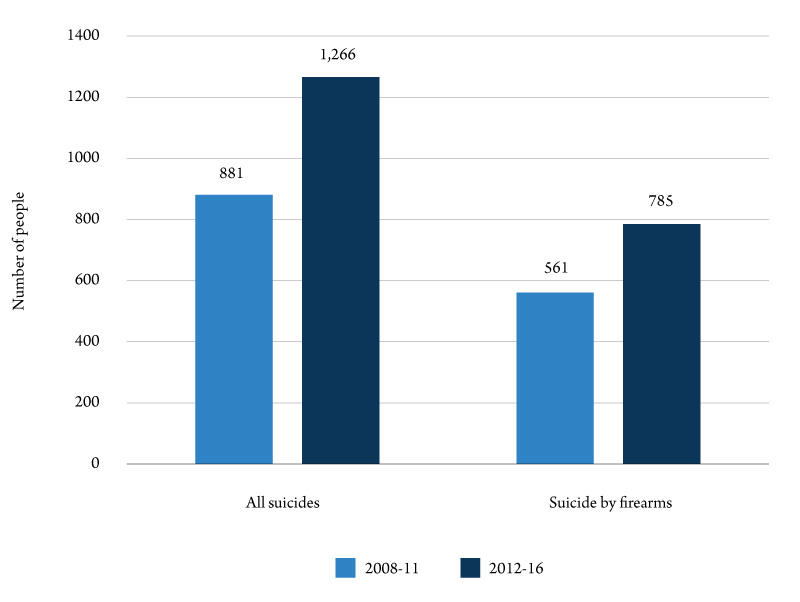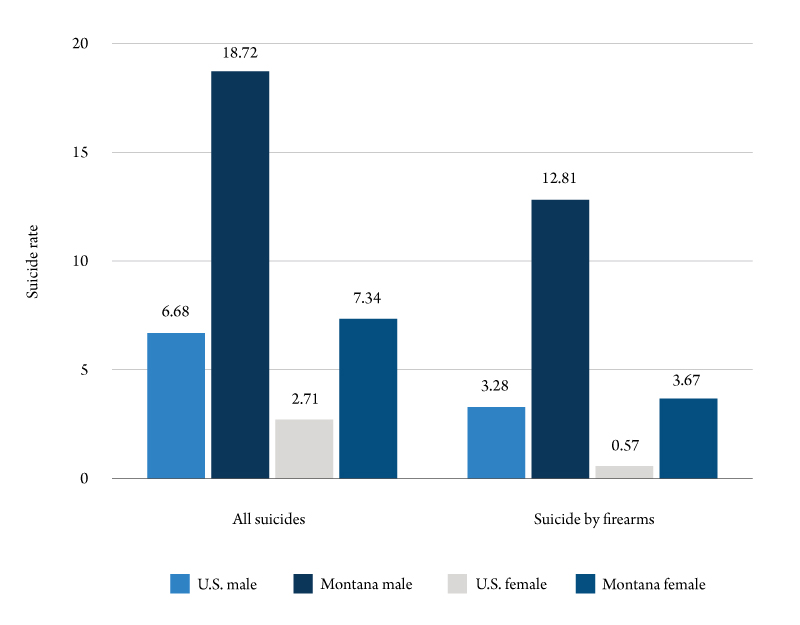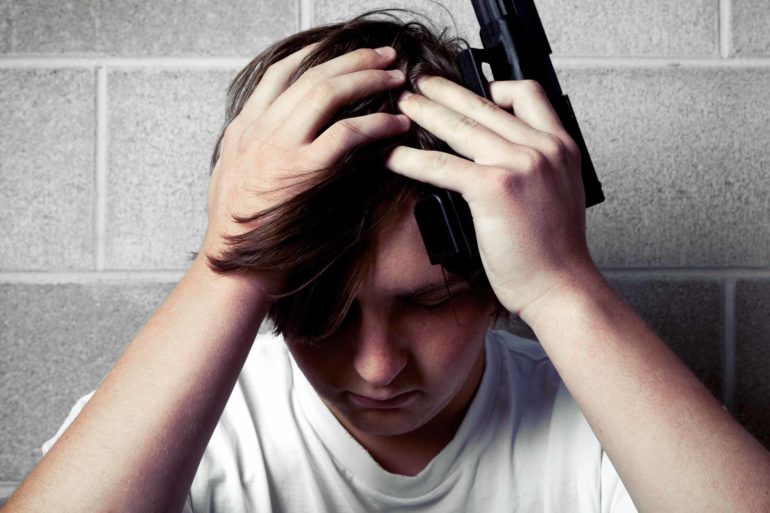Montana persistently ranks in the top three states with the most youth who die by suicide – and their method of choice is overwhelmingly firearms. Preventing youth from killing themselves should and must be a priority, yet nothing sets off an ideological firestorm like the mention of gun regulation in America. It is difficult to talk about youth suicide without addressing the means most often used though, and the only way to ensure that a young person doesn’t use a gun to kill themselves is to prevent access to one.
Youth suicide prevention requires a multifaceted approach. However, the fact remains that from 2014-16, 62 percent of Montanans who died by suicide used a gun. While the percentage of firearms used by Montanans to successfully kill themselves has stayed consistently high for years, the numbers of people dying has risen significantly (Figure 1).

Using a gun as a means to kill oneself is significant because people are far more likely to die using a firearm than from any other means – 83 percent of suicide attempts using a firearm results in death. This is particularly important because if someone survives a suicide attempt they are unlikely to try again. Among those who have attempted suicide, 70 percent make no further attempts.
Youth Suicide and Firearms
Nationally, 39 percent of youth ages 11 to 17 who committed suicide used a firearm to kill themselves. In Montana, that number is significantly higher (63 percent). Figure 2 shows the rates at which male and female youth in Montana die using a firearm versus the United States as a whole. It’s important to note not only the rate by which both males and females kill themselves with firearms, but the significant difference in the rate between girls in Montana and girls overall: Girls in Montana kill themselves at a rate that’s six times higher than the rest of the country.

What means people choose is a complex interaction of seriousness of intent, availability of means, cultural norms or acceptability of means and preconceived notions of lethality. Choosing a firearm has a high potential for success (seriousness). Guns also are readily available – 42 percent of Americans and 58 percent of Montanans live in a household with a gun – and firearms are culturally acceptable (the Second Amendment to the U.S. Constitution enshrines the right to keep and bear arms). Thus, culture plays a large part in what means are chosen, especially in the context of youth suicide in Montana.
Growing up with firearms does not make an individual more prone to suicide. But if a gun is present in a household, having access is an important consideration. Almost half of all people who’ve survived a suicide attempt report that they spent less than 10 minutes deliberating between the emergence of suicidal thoughts and the actual attempt. Therefore, delaying access is important so that someone has time to consider their actions.
While a majority of gun owners with children are careful to unload and lock up their firearms, 46 percent of gun owners with children do not keep their guns locked, and 47 percent keep a loaded weapon in their home. Thirty-eight percent of gun owners reported that they always keep a loaded gun within easy reach, whether they have children in the home or not.
Policies that have proven successful in reducing youth suicide with guns are largely child access prevention laws, which include safe storage laws and minimum age requirements for purchasing a firearm. Child access prevention laws lower both the total number of suicides and the number of suicides with a firearm.
Montana law prohibits anyone who has charge of a child under 14 years old from allowing that child to carry or use a firearm in public. The exception is if the child is accompanied by a legal guardian or parent, is being supervised by a qualified firearms safety instructor or is with someone who has charge or custody of the minor. A violation constitutes a misdemeanor.
Safe storage laws refer specifically to laws requiring firearm locking devices to be in place or requiring gun owners to keep their firearms out of the reach of others, such as children or prohibited persons. Montana does not require a locking device to accompany the sale of a weapon, and no Montana statute requires firearm owners to lock or secure their weapons, although the federal law applies. Additionally, Montana imposes no specific age restrictions on the purchase or possession of any firearm.

More research into the connection between firearm laws and suicide is needed to help inform gun policy. However, federal agencies are limited in what data they may or may not collect. For instance, the Center for Disease Control and Prevention is restricted by Congress from gathering data on gun violence – a restriction that should be lifted.
Non-Legislative Approaches
Non-legislative approaches to gun policy might be the best hope in addressing the issue, as gun regulation is a highly polarized topic. Non-legislative approaches do not require passing laws, and they are less likely to be misinterpreted as gun control. These approaches include counseling at-risk youth and their families, promoting educational campaigns and partnering with other key players, such as providers, gatekeepers and gun owner groups.
Despite the different attitudes around gun policies, there is some agreement between gun owners and non-gun owners when it comes to gun safety in households with children – those include talking with children about gun safety, taking gun safety courses and keeping firearms locked up.
Groups from the private and public sectors in Montana have implemented some non-legislative approaches to reducing youth access to firearms. For instance, a pediatric group in Bozeman partnered with the Rural Institute for Veteran Education and Research to provide 1,000 trigger locks to families with children under 12. Since 2007, the Montana Department of Public Health and Human Services has distributed over 20,000 gun locks with suicide prevention tags, and free gun locks are available at most local health departments, police and fire stations across the state.
Youth suicide is a public health crisis. Keeping guns out of the hands of youth who are having suicidal thoughts makes sense, and delaying action has proven to give them time to reassess their choices. But Montana needs to strengthen its child access restriction laws, safe storage laws and minimum age requirements to purchase a firearm. Sadly, in the current political climate, Montanans may not have the political will to pass such laws. Until broader laws can be passed, the best approach might be community level education and discussion, as well as higher state funding levels for Montana’s suicide prevention efforts.


